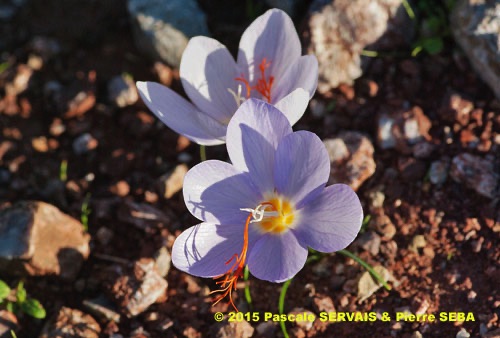
Crocus tournefortii J.Gay
Fam. : Iridaceae
Plante herbacée, hermaphrodite, sans tige visible, à bulbe ovoïde parfois couvert de fibres parallèles.
Feuilles à la base, simples, entières, linéaires, par 3 à 8, glabres, présentes à la floraison, de 1 à 3 mm de large, vertes, avec une ligne centrale blanche.
Fleurs à symétrie radiaire, bleu pâle, mauves ou lilas, de 3 à 4 cm de diamètre, unies, à gorge jaune. Périanthe à 6 tépales, de 15 à 36 mm de long, de 10 à 13 mm de large, largement émoussés au sommet, soudés à la base en un tube rayé de blanc et de brun. 2 bractées membraneuses présentes à la base du tube à la floraison. 3 étamines à filet jaune et à anthère blanche. 1 style ramifié rougeâtre ou orange, beaucoup plus long que les étamines et plus long que les tépales. Ovaire infère, situé sous le niveau du sol.
Fruits, capsules à 3 loges.
___________________________
Plant herbaceous, hermaphrodite, without a conspicuous stem, with ovoid corm sometimes covered in parallel fibres.
Leaves at the base, simple, entire, linear, by 3 to 8, glabrous, present at flowering, from 1 to 3 mm across, green, with a white central line.
Flowers radially symmetrical, pale blue, mauve or lilac, from 3 to 4 cm in diameter, self-coloured, with a yellow throat. Perianth with 6 tepals, from 15 to 36 mm long, from 10 to 13 mm across, widely blunted at the top, partly fused in a white and brown striped tube. 2 membranous bracts present at the base of the tube at flowering. 3 stamens with a yellow filament and a white anther. 1 reddish or orange, branched style, much longer than stamens and longer than the tepals. Ovary inferior, located under ground level.
Fruits, capsules with 3 loculi.
Descripteurs / Identifying features
1
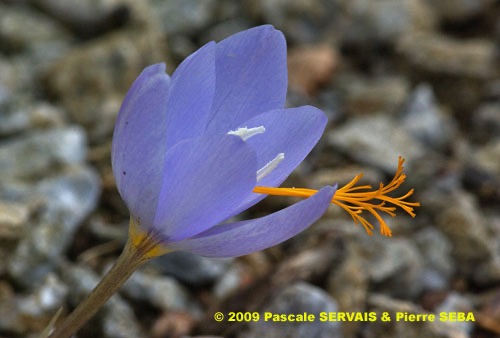
2
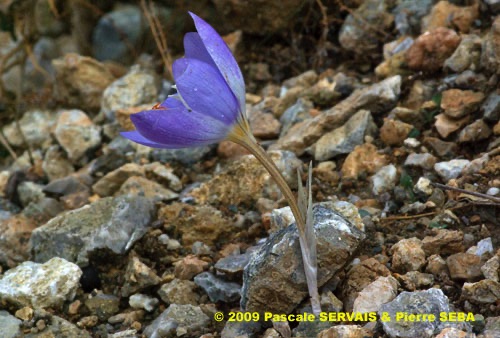
3
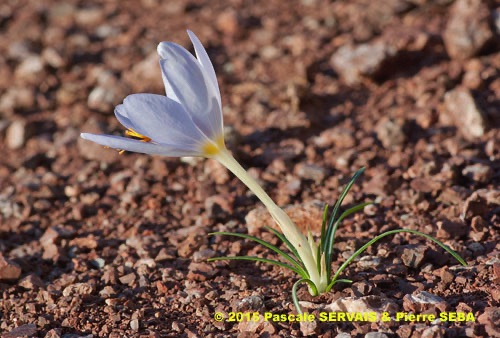
4
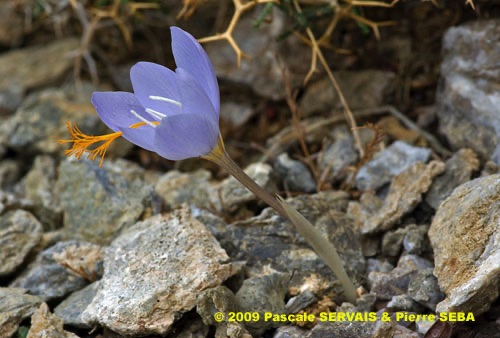
5
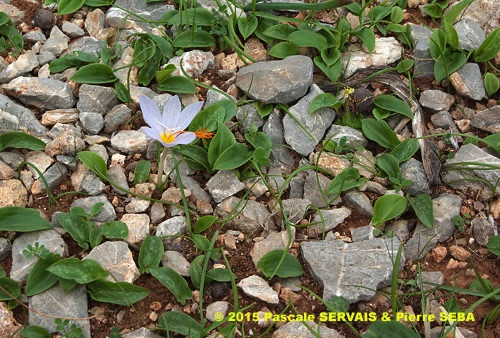
6
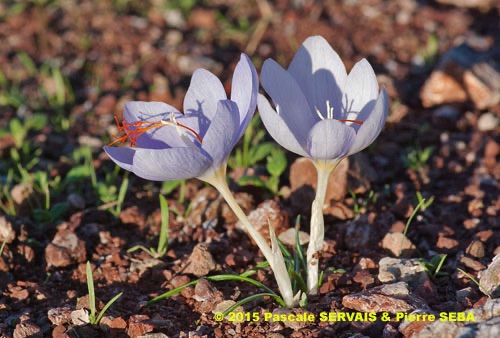
7
Étymologie / Etymology :
Crocus : emprunt du latin crocus, -i (nom) = le safran, nom donné par
Pline aux étamines jaunes de certaines fleurs, forme latinisée du grec
ancien κρόκος, -ου (nom) = le safran, le crocus.
Tournefortii : nom donné en l’honneur de Joseph Pitton de Tournefort
(1656-1708), botaniste français qui fut professeur de botanique au
Jardin des Plantes à Paris.
Crocus : borrowed from Latin crocus, -i (noun) = saffron, name given
by Plinius to the yellow stamens of some flowers, Latinized form of
the Classical Greek κρόκος, -ου (noun) = saffron, crocus.
Tournefortii : name given in honour of Joseph Pitton de Tournefort
(1656-1708), French botanist who was a professor of botany at the
Jardin des Plantes in Paris.
Synonymes / Synonyms :
Crocus orphanidis Hook.f.
Crocus pholegandrius Orph.
Crocus tournefortianus Herb.
Noms vernaculaires / Common names :
Nom français / French name :
Crocus de Tournefort.
Noms grecs / Greek names :
Κρόκος — Κρόκος του Tournefort — Σαφράνι.
Nom anglais / English name :
Tournefort’s crocus.
Nom allemand / German name :
Tourneforts Krokus.
Habitat :
Lieux pierreux - Murs, rochers.
Stony places - Walls, rocks.
Îles / Islands :
Karpathos - Rhodos - Tilos.
Hauteur / Height range :
De 5 cm à 10 cm.
From 5 cm to 10 cm.
Floraison / Flowering time :
De septembre à décembre.
From September to December.
Groupe / Classification :
Monocotylédones.
Monocotyledons.
Pérennité / Lifespan :
Vivace.
Perennial.
Description :
Photo 1 :
Localisation / Location : Tilos, Livadia, Pano Meri
Date : 20/11/2014
GPS : Lat. 36,39754° N / Long. 27,40043° E / Alt. 258 m
Type : Photographie numérique / Digital Photograph (10 mégapixels)
Photo 2 :
Localisation / Location : Tilos, Livadia, Pano Meri
Date : 27/10/2009
GPS : Lat. 36,39762° N / Long. 27,40115° E / Alt. 261 m
Type : Photographie numérique / Digital Photograph (10 mégapixels)
Photo 3 :
Localisation / Location : Tilos, Livadia, Pano Meri
Date : 27/10/2009
GPS : Lat. 36,39762° N / Long. 27,40115° E / Alt. 261 m
Type : Photographie numérique / Digital Photograph (10 mégapixels)
Photo 4 :
Localisation / Location : Tilos, Livadia, Pano Meri
Date : 20/11/2014
GPS : Lat. 36,39725° N / Long. 27,40010° E / Alt. 253 m
Type : Photographie numérique / Digital Photograph (10 mégapixels)
Photo 5 :
Localisation / Location : Tilos, Livadia, Pano Meri
Date : 27/10/2009
GPS : Lat. 36,39762° N / Long. 27,40115° E / Alt. 261 m
Type : Photographie numérique / Digital Photograph (10 mégapixels)
Photo 6 :
Localisation / Location : Tilos, Livadia, Environs
Date : 24/11/2010
GPS : Lat. 36,41979° N / Long. 27,38263° E / Alt. 185 m
Type : Photographie numérique / Digital Photograph (10 mégapixels)
Photo 7 :
Localisation / Location : Tilos, Livadia, Pano Meri
Date : 20/11/2014
GPS : Lat. 36,39754° N / Long. 27,40043° E / Alt. 258 m
Type : Photographie numérique / Digital Photograph (10 mégapixels)
© Pascale SERVAIS & Pierre SEBA, 2018. Tilo Botanica: Flore de Tilos et du Dodécanèse / Flora of Tilos and of the Dodecanese
English translation by Brenda Bradbury, Howard Bradbury and Stéphane Léonard
Clés dichotomiques et descripteurs distinctifs des 2 espèces / Dichotomous keys and distinctive identifying features of the 2 species

Google Maps
Google Maps
Google Maps
Google Maps
Google Maps
Google Maps
Google Maps